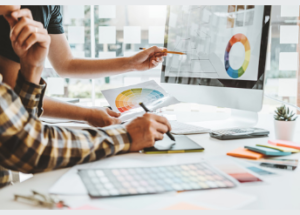What Is Graphic Design?
Icon-Graphic-Design graphic design Adelaide is the art of using images, typefaces and white space to convey a message. From billboards and posters to magazines or computer screens, graphic designers create and select these elements to share information, persuade, organise, stimulate, locate, identify, grab attention and provide pleasure.
 Graphic designers must often collaborate with clients and other creatives to realise their ideas. While interpreting and responding to feedback can be tricky, it’s essential for creating a successful project you can be proud of.
Graphic designers must often collaborate with clients and other creatives to realise their ideas. While interpreting and responding to feedback can be tricky, it’s essential for creating a successful project you can be proud of.
White Spaces
White space is an integral component of Icon-Graphic-Design graphic design Adelaide, helping to promote clarity and emphasis in everything from newsletters and banners to business cards and websites. It can also be utilised to distinguish unique components within an artwork, making it more straightforward for viewers or users to navigate its contents.
It is essential to comprehend how white space works in graphic design so you can make informed decisions when selecting design assets. Unfortunately, this principle often goes overlooked, yet it is an invaluable asset for any designer aiming to produce visually appealing work.
Several considerations need to be taken when selecting how to utilise white space. First and foremost, identify which elements of composition require viewer or user attention and then strategically plan how to use white space accordingly.
Second, it is essential to distinguish micro from macro white spaces. Micro refers to the distance between small elements such as text lines, paragraphs, icons and buttons; macro refers to more significant components like text columns and graphics.
Though stuffing white space with more details may be tempting, white space helps improve your design’s visual hierarchy and prevent cognitive fatigue. It is because fewer distracting details confuse viewers or users.
Designing with white space and other design principles such as colour and contrast can help to draw the eye to critical elements, increasing their visual impact and appeal.
As a general guideline, designers should always maintain consistency regarding the size and spacing of all elements within their design, including margins and gutters. Ensuring each area has adequate room can significantly boost your design’s impact.
White space is an integral element of design, but figuring out how best to utilise it can be challenging. Fortunately, some guidelines can help you decide how to incorporate them into your strategy.
Symmetrical or Asymmetrical Compositions
Symmetrical compositions are those in which the visual weight of elements on either side of an axis is equal. This balance is often employed in graphic design projects that require formality and structure, such as event invitations or business cards.
Symmetrical compositions can be an effective tool to focus attention on the most critical information and make a design stand out from its peers. However, they may also become boring, so you should carefully consider your target audience and the message you want to convey before opting for such an approach.
As an alternative to symmetrical balance, designers can opt for asymmetrical equilibrium. Asymmetrical equilibrium creates more visual interest than its symmetrical counterpart and adds tension to a design. While it requires more thought and effort, asymmetrical compositions offer great possibilities to add variety to your composition.
If you’re searching for an inspiring example of asymmetrical balance in a composition, Van Gogh’s The Starry Night is a prime example. Here, the top and bottom parts differ in size and hue yet still create harmony within the composition.
Balance is an essential element of successful compositions. It measures the visual weight of each region and determines how it draws your audience’s eye.
Asymmetrical balance can be more challenging than symmetrical, but the rewards are worth the effort. Asymmetrical balance gives your design more contrast and makes it stand out from competitors.
Asymmetrical balance can be an effective tool for breaking up patterns. Humans process visual information quickly, so asymmetrical balance helps your audience focus more on specific parts of your design and extends their time engaging with it.
Repetitive Components
Icon-Graphic-Design graphic design Adelaide is an art form that carefully conceals visual content into a practical and unified whole. To do this, designers employ principles like contrast, balance, alignment, proximity and repetition throughout their work.
Repetition uses similar or identical elements throughout a design, such as fonts, colours or shapes.